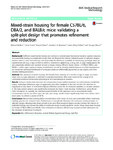Mixed-strain housing for female C57BL/6, DBA/2, and BALB/c mice: validating a split-plot design that promotes refinement and reduction
| dc.contributor.author | Walker, M | |
| dc.contributor.author | ESTEBAN , ARRIBAS REYES | |
| dc.contributor.author | Palme, R | |
| dc.contributor.author | Newman, JA | |
| dc.contributor.author | Ahloy Dallaire, J | |
| dc.contributor.author | Mason, G | |
| dc.date.accessioned | 2017-12-12T18:06:43Z | |
| dc.date.available | 2017-12-12T18:06:43Z | |
| dc.date.issued | 2016-12 | |
| dc.identifier.issn | 1471-2288 | |
| dc.identifier.issn | 1471-2288 | |
| dc.identifier.other | 11 | |
| dc.identifier.uri | http://hdl.handle.net/10026.1/10416 | |
| dc.description.abstract |
Background Inefficient experimental designs are common in animal-based biomedical research, wasting resources and potentially leading to unreplicable results. Here we illustrate the intrinsic statistical power of split-plot designs, wherein three or more sub-units (e.g. individual subjects) differing in a variable of interest (e.g. genotype) share an experimental unit (e.g. a cage or litter) to which a treatment is applied (e.g. a drug, diet, or cage manipulation). We also empirically validate one example of such a design, mixing different mouse strains -- C57BL/6, DBA/2, and BALB/c -- within cages varying in degree of enrichment. As well as boosting statistical power, no other manipulations are needed for individual identification if co-housed strains are differentially pigmented, so also sparing mice from stressful marking procedures. Methods The validation involved housing 240 females from weaning to 5 months of age in single- or mixed- strain trios, in cages allocated to enriched or standard treatments. Mice were screened for a range of 26 commonly-measured behavioural, physiological and haematological variables. Results Living in mixed-strain trios did not compromise mouse welfare (assessed via corticosterone metabolite output, stereotypic behaviour, signs of aggression, and other variables). It also did not alter the direction or magnitude of any strain- or enrichment-typical difference across the 26 measured variables, or increase variance in the data: indeed variance was significantly decreased by mixed- strain housing. Furthermore, using Monte Carlo simulations to quantify the statistical power benefits of this approach over a conventional design demonstrated that for our effect sizes, the split- plot design would require significantly fewer mice (under half in most cases) to achieve a power of 80 %. Conclusions Mixed-strain housing allows several strains to be tested at once, and potentially refines traditional marking practices for research mice. Furthermore, it dramatically illustrates the enhanced statistical power of split-plot designs, allowing many fewer animals to be used. More powerful designs can also increase the chances of replicable findings, and increase the ability of small-scale studies to yield significant results. Using mixed-strain housing for female C57BL/6, DBA/2 and BALB/c mice is therefore an effective, efficient way to promote both refinement and the reduction of animal-use in research. | |
| dc.format.extent | 0-0 | |
| dc.format.medium | Electronic | |
| dc.language | en | |
| dc.language.iso | en | |
| dc.publisher | Springer Science and Business Media LLC | |
| dc.subject | Mice | |
| dc.subject | Refinement | |
| dc.subject | Reduction | |
| dc.subject | Animal Welfare | |
| dc.subject | Experimental Design | |
| dc.subject | Split-Plot | |
| dc.title | Mixed-strain housing for female C57BL/6, DBA/2, and BALB/c mice: validating a split-plot design that promotes refinement and reduction | |
| dc.type | journal-article | |
| dc.type | Journal Article | |
| dc.type | Research Support, Non-U.S. Gov't | |
| plymouth.author-url | https://www.webofscience.com/api/gateway?GWVersion=2&SrcApp=PARTNER_APP&SrcAuth=LinksAMR&KeyUT=WOS:000368654200001&DestLinkType=FullRecord&DestApp=ALL_WOS&UsrCustomerID=11bb513d99f797142bcfeffcc58ea008 | |
| plymouth.issue | 1 | |
| plymouth.volume | 16 | |
| plymouth.publication-status | Published | |
| plymouth.journal | BMC Medical Research Methodology | |
| dc.identifier.doi | 10.1186/s12874-016-0113-7 | |
| plymouth.organisational-group | /Plymouth | |
| plymouth.organisational-group | /Plymouth/Faculty of Science and Engineering | |
| plymouth.organisational-group | /Plymouth/REF 2021 Researchers by UoA | |
| plymouth.organisational-group | /Plymouth/REF 2021 Researchers by UoA/UoA04 Psychology, Psychiatry and Neuroscience | |
| dc.publisher.place | England | |
| dcterms.dateAccepted | 2016-01-19 | |
| dc.identifier.eissn | 1471-2288 | |
| dc.rights.embargoperiod | Not known | |
| rioxxterms.versionofrecord | 10.1186/s12874-016-0113-7 | |
| rioxxterms.licenseref.uri | http://www.rioxx.net/licenses/all-rights-reserved | |
| rioxxterms.licenseref.startdate | 2016-12 | |
| rioxxterms.type | Journal Article/Review |


